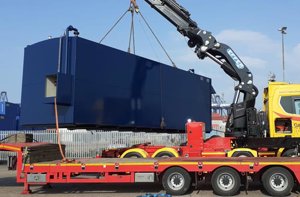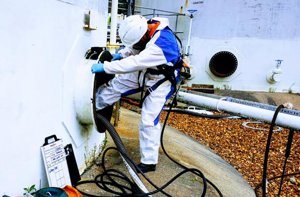
Storage tank solutions
We help organisations with any type, volume, and number of tanks on their sites to install, inspect, test, and maintain them compliantly so that they can reduce the risk of damaging the environment, operational downtime, regulatory fines, and protect their reputation in the event of a pollution incident.
Primary containment is the most important means of preventing major pollution incidents and includes equipment in direct contact with the substances being stored such as tanks, vessels, pipework, valves, and pumps as well as equipment that prevents the loss of contaminants under abnormal conditions.
Tanks are subject to various regulations, standards, and good practice guidance, from COMAH, BS EN 14015:2004, EEMUA, API 650, and the Oil Storage Regulations, depending on the contents and tank material.
How we can help

Design and installation

Inspection and testing

Cleaning and maintenance
Stay compliant
Maintain compliance with regulations, standards, and good practice guidance, including:
- The Control of Major Accident Hazards (COMAH) Regulations 2015
- BS EN 14015:2004
- EEMUA 159
- API 650
- The Control of Pollution (Oil Storage) (England) Regulations 2001
- The Water Resources (Control of Pollution) (Oil Storage) (Wales) Regulations 2016
- The Water Environment (Oil Storage) (Scotland) Regulations 2006
- The Control of Pollution (Oil Storage) Regulations (Northern Ireland) 2010
Qualified technicians
Our qualified technicians are members of a professional scheme for tank installers, including:
- Petroleum Equipment Installers and Maintenance Federation (PEIMF)
- Engineering Equipment and Materials Users Association (EEMUA)
- Oil Firing Technical Association (OFTEC)
Two of the key pieces of legislation that you could breach if you don’t properly maintain your primary containment are:
The Water Resources Act 1991 states that ‘It is an offence to cause or knowingly permit any poisonous, noxious or polluting material, or any solid waste to enter any controlled water.’
Environmental Permitting Regulations 2016 state that ‘It is an offence to cause or knowingly permit a water discharge activity or a groundwater activity without an environmental permit.’
A pollution incident because of a poorly maintained asset or inadequate containment is a strict liability offence and failure to adhere to standards and good practice guidance is a key factor in considering enforcement action.
The onus is on operators to demonstrate compliance with regulation to reduce the risk of a pollution incident. A robust asset maintenance programme is essential for providing the information needed for service log scrutiny in the event of an incident or during routine environmental inspections.
The implications of failing to adequately protect the environment range from environmental, legal, financial, and reputational.
There has also been a marked increase in the level of fines over the last decade, especially for large companies. In certain circumstances, senior officers of offending businesses have been held personally liable.
Spillages can cause significant damage to the environment. Oil users and tank owners have a legal responsibility to maintain their tanks and are directly responsible for any clean-up costs.
Relevant standards and good practice relating to storage tanks
- SFG20
- OFTEC Standards
- HSG 176: Storage of Flammable Liquids in Tanks
- GPP 2: Above Ground Oil Storage Tanks (Jan 2016)
- CIRIA C736 Containment Systems for the Prevention of Pollution
- The Control of Pollution (Oil Storage) Regulations 2001
- The APEA Blue Book (4th Edition) 2018
- EEMUA 159 – Above Ground Flat Bottom Storage Tanks
- EEMUA 255 – Above Ground Plastic Tanks
- API 653 – Tank Inspection, Repair, Alteration and Reconstruction
- API 575 - Inspection Practices
- API 650 – Welded Tanks for Oil Storage
- BSEN 12285 Horizontal Steel Tanks Part 1 and 2
- BSEN 14015:2004 Vertical Steel Tanks
- BS 799-5:2010 Carbon Steel Oil Storage Tanks
GPP2: Above Ground Oil Storage Tanks
Several key elements and guidance are noted in the document:
- Complying with Oil Storage Regulations
- Deciding the location of an oil storage tank
- Types of oil storage tank
- Installation
- Ancillary Equipment / Pipework & Deliveries
- Legal Compliance for existing tanks
- Maintenance & Security
- Oil Spills
HSG 176: Storage of Flammable Liquids in Tanks
Several key elements and guidance are noted in the document:
- Containment / separation / ventilation control measures
- Location and layout of tanks
- Design and construction of tanks including; double-skinned tanks, corrosion, pipework and bunding
- Loading and unloading facilities
- Inspection and maintenance
- Security
*The reclassification of diesel as a flammable liquid under the CLP legislation has serious implications for the storage and use of diesel/gas oil.
The HSG 176 update has brought any products with a flashpoint of up to 60 degrees into the requirements of HSG 176 including diesel.
Keep your business compliant and protect the environment while reducing the risk of operational downtime
Find out how Adler and Allan reduce your risk and support you on your journey to Net-Zero through the management and maintenance of assets.
Contact our experts

